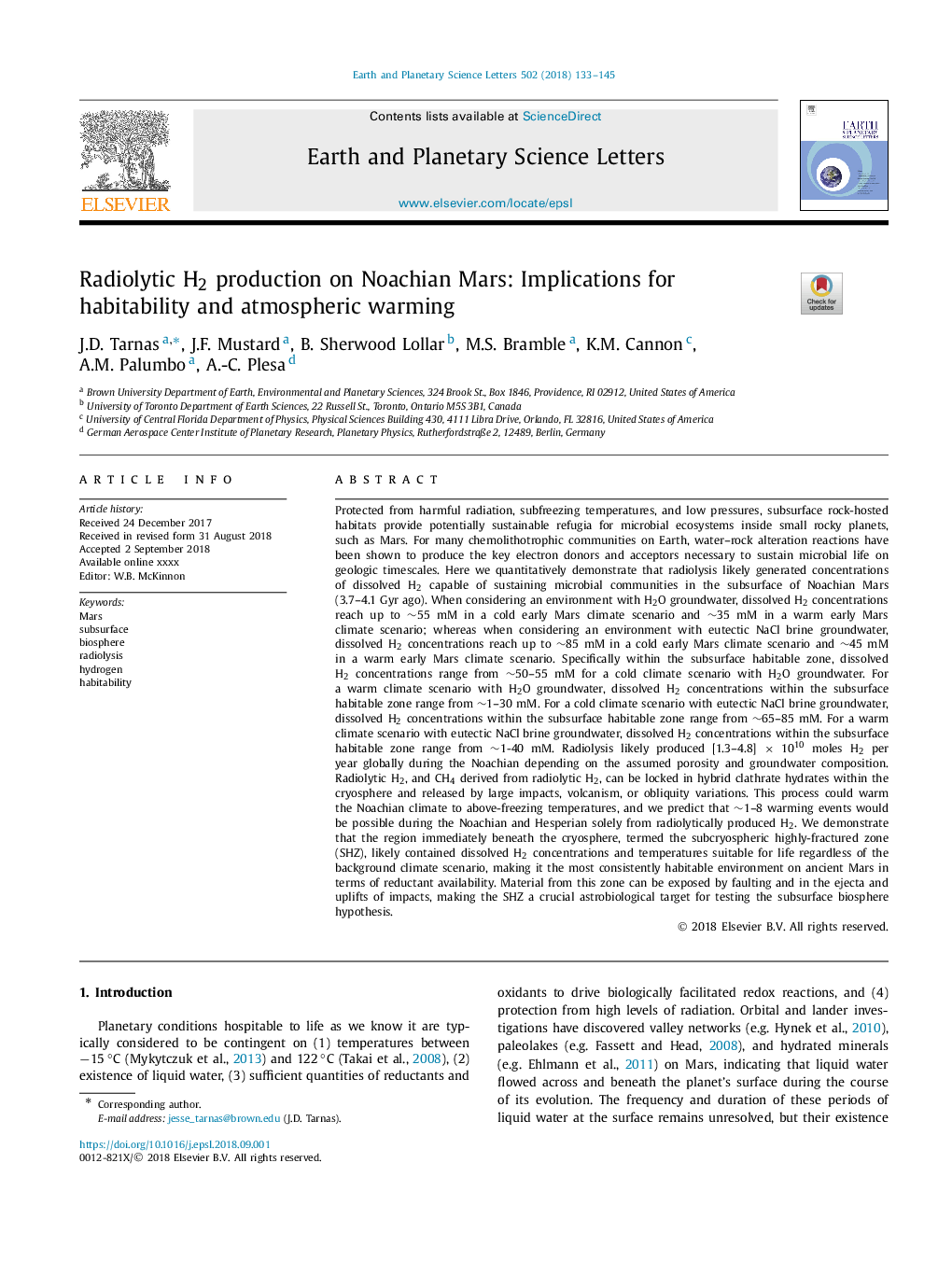| کد مقاله | کد نشریه | سال انتشار | مقاله انگلیسی | نسخه تمام متن |
|---|---|---|---|---|
| 9951470 | 1646778 | 2018 | 13 صفحه PDF | دانلود رایگان |
عنوان انگلیسی مقاله ISI
Radiolytic H2 production on Noachian Mars: Implications for habitability and atmospheric warming
دانلود مقاله + سفارش ترجمه
دانلود مقاله ISI انگلیسی
رایگان برای ایرانیان
کلمات کلیدی
موضوعات مرتبط
مهندسی و علوم پایه
علوم زمین و سیارات
علوم زمین و سیاره ای (عمومی)
پیش نمایش صفحه اول مقاله

چکیده انگلیسی
Protected from harmful radiation, subfreezing temperatures, and low pressures, subsurface rock-hosted habitats provide potentially sustainable refugia for microbial ecosystems inside small rocky planets, such as Mars. For many chemolithotrophic communities on Earth, water-rock alteration reactions have been shown to produce the key electron donors and acceptors necessary to sustain microbial life on geologic timescales. Here we quantitatively demonstrate that radiolysis likely generated concentrations of dissolved H2 capable of sustaining microbial communities in the subsurface of Noachian Mars (3.7-4.1 Gyr ago). When considering an environment with H2O groundwater, dissolved H2 concentrations reach up to â¼55 mM in a cold early Mars climate scenario and â¼35 mM in a warm early Mars climate scenario; whereas when considering an environment with eutectic NaCl brine groundwater, dissolved H2 concentrations reach up to â¼85 mM in a cold early Mars climate scenario and â¼45 mM in a warm early Mars climate scenario. Specifically within the subsurface habitable zone, dissolved H2 concentrations range from â¼50-55 mM for a cold climate scenario with H2O groundwater. For a warm climate scenario with H2O groundwater, dissolved H2 concentrations within the subsurface habitable zone range from â¼1-30 mM. For a cold climate scenario with eutectic NaCl brine groundwater, dissolved H2 concentrations within the subsurface habitable zone range from â¼65-85 mM. For a warm climate scenario with eutectic NaCl brine groundwater, dissolved H2 concentrations within the subsurface habitable zone range from â¼1-40 mM. Radiolysis likely produced [1.3-4.8] Ã 1010 moles H2 per year globally during the Noachian depending on the assumed porosity and groundwater composition. Radiolytic H2, and CH4 derived from radiolytic H2, can be locked in hybrid clathrate hydrates within the cryosphere and released by large impacts, volcanism, or obliquity variations. This process could warm the Noachian climate to above-freezing temperatures, and we predict that â¼1-8 warming events would be possible during the Noachian and Hesperian solely from radiolytically produced H2. We demonstrate that the region immediately beneath the cryosphere, termed the subcryospheric highly-fractured zone (SHZ), likely contained dissolved H2 concentrations and temperatures suitable for life regardless of the background climate scenario, making it the most consistently habitable environment on ancient Mars in terms of reductant availability. Material from this zone can be exposed by faulting and in the ejecta and uplifts of impacts, making the SHZ a crucial astrobiological target for testing the subsurface biosphere hypothesis.
ناشر
Database: Elsevier - ScienceDirect (ساینس دایرکت)
Journal: Earth and Planetary Science Letters - Volume 502, 15 November 2018, Pages 133-145
Journal: Earth and Planetary Science Letters - Volume 502, 15 November 2018, Pages 133-145
نویسندگان
J.D. Tarnas, J.F. Mustard, B. Sherwood Lollar, M.S. Bramble, K.M. Cannon, A.M. Palumbo, A.-C. Plesa,